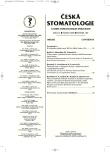The Growth of Caries in Primary Teeth and Some Correlations in a Longitudinal Study
Authors:
Z. Broukal 1; R. Ivančaková 2; E. Lenčová 1
Authors‘ workplace:
Výzkumný ústav stomatologický 1. LF UK a VFN, Praha
1; Stomatologická klinika LF UK a FN, Hradec Králové
2
Published in:
Česká stomatologie / Praktické zubní lékařství, ročník 109, 2009, 2, s. 25-29
Overview
Caries experience dental status, oral hygiene and salivary levels of cariogenic streptococci were examined in the three years prospective study among older preschool children in relation to the dynamics of caries increment and with regard to the educational level of their mothers. Mean caries increment between the second and third year of study did not differ significantly amounting to 0.3 new decayed teeth per year however it was highest among children caries free in the onset of study. Higher caries experience significantly positively correlated with the presence of dental plaque and in the final of study also with the salivary levels of cariogenic streptococci. Mothers of caries free children assigned significantly higher educational level than those of children with tooth decay and on the contrary the proportion of children at need of restorative care was highest among mothers with elementary educational level. The educational level of mothers can be taken as the significant predictor of caries risk in children and as such it can be taken as one of important causes of the inequalities in oral health of children.
Key words:
caries experience - dental status - caries increment - preschool children - caries risk factors
Sources
1. Armfield, J. M.: Socioeconomic inequalities in child oral health: a comparison of discrete and composite area-based measures. J. Public. Health Dent., 67, 2007, 2, s. 119-125.
2. Enjary, C., Tubert-Jeannin, S., Manevy, R., Roger-Leroi, V., Riordan, P. J.: Dental status and measures of deprivation in Clermont-Ferrand, France. Community Dent. Oral Epidemiol., 34, 2006, 5, s. 363-371.
3. Ferro, R., Besostri, A., Olivieri, A., Stellini, E., Mazzoleni, S.: Preschoolers’ dental caries experience and its trend over 20 years in a North-East Italian Health district. Eur J. Pediatr. Dent., 8, 2007, 4, s. 199-204.
4. Grindefjord, M., Dahllöf, G., Nilsson, B., Moder, T.: Stepwise prediction of dental caries in children up to 3.5 years of age. Caries Res., 30, 1996, 4, s. 256-266.
5. Ivančaková, R., Broukal, Z., Lenčová, E., Mrklas, L.: Longitudinální studie orálního zdraví předškolních dětí – výsledky vstupního klinického vyšetření. Čes. Stomat., 107, 2007, s. 113-116.
6. Kráter, E., Dyson, K., Tennant, M.: Pre-school child oral health in rural Western Australia. Aust. Dent. J., 50, 2005, 4, s. 258-262.
7. Lenčová, E., Broukal, Z., Dušková, J.: Psychosocial, behavioural and oral health indicators – review of the literature. Prague Medical Report, 107, 2006, s. 305-316.
8. Lenčová, E., Pikhart, H., Broukal, Z.,Tsakos, G.: Does parental locus of control influence caries experience in preschool children? BioMed. Central Public. Health, v tisku.
9. Pienihäkkinen, K., Jokela, J., Alanen, P.: Assessment of caries risk in preschool children. Caries Res., 38, 2004, 2, s. 156-162.
10. Reisine, S. T., Poster, W.: Socioeconomic status and selected behavioral determinants as risk factors for dental caries. J. Dent. Educ., 65, 2001, 10, s. 1009-1016.
11. Seminario, A., Broukal, Z., Ivančaková, R.: Mutans streptococci and the development of dental plaque. Prague Med. Rep., 106, 2005, 4, s. 349-358.
12. Skeie, M. S., Raadal, M., Strand, G. V., Espelid, I.: Caries in primary teeth at 5 and 10 years of age: a longitudinal study. Eur J. Paediatr Dent., 5, 2004, 4, s. 194-202.
13. Thenisch, N. L., Bachmann, L. M., Imfeld, T., Leisebach Minder, T., Steurer, J.: Are mutans streptococci detected in preschool children a reliable predictive factor for dental caries risk? A systematic review. Caries Res., 40, 2006, 5, s. 366-374.
14. Senft, L. K., Hallonsten, A. L., Koch, G.: Oral health in pre-school children living in Sweden. Part III—A longitudinal study. Risk analyses based on caries prevalence at 3 years of age and immigrant status. Swed Dent J., 23, 1999, 1, s. 17-25.
Labels
Maxillofacial surgery Orthodontics Dental medicineArticle was published in
Czech Dental Journal

2009 Issue 2
Most read in this issue
- Oral Complications of Intraoral Piercing
- Ultrasound Examination of Cervical Nodes in Treatment of Oral Cavity Carcinoma
- Effect of Peroxide Bleaching Systems on the Marginal Integrity and Surface Hardness of Composite Restorations
- Implant Design
